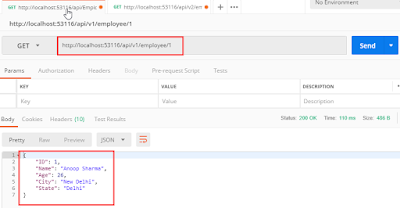Let’s
think of a scenario where you are having the fever, you go to a medical
shop and ask for medicine but then in return, the medical guy asked
which or what type of medicine you need. Ooopz!! Now what? You land up
visiting the doctor who understands your needs and writes down the
medicine which would work for you. Amazing!! Isn’t it. You got your work
done with just a call of service. And that’s what Dependency Injection
is in software development.
Dependency Injection aka DI is a way in which one object (The Doctor) is capable to give the dependencies of another object (The patient) as per the need. I won’t be going in depth of explaining
Similarly you can change the code structure for other action methods to use Ninject.
Dependency Injection aka DI is a way in which one object (The Doctor) is capable to give the dependencies of another object (The patient) as per the need. I won’t be going in depth of explaining
Dependency Injection in this article though.Dependnecy Injection Containers
In the above scenario, different doctors have different ways of treating the illness or giving you the service as per need. Similarly, there are different kinds, popularly known as containers, of dependency injection. In other ways, different design patterns for the dependency injection containers. Below are few of them.- Castle Windsor : This is one of the mature and best Inversion of Control container for .NET and Silverlight applications
- Unity : If you are looking for Lightweight extensible
dependency injection container, Unity is one of the container you can
select from. It comes with support for constructor, property, and method
call injection
- Autofac : One of the preferred IoC
- DryIoc : Simple, fast and fully featured IoC container.
- Ninject : Called as ninja of .NET dependency injectors
- StructureMap : The original IoC/DI Container for .Net
- Spring.Net
- Open source application framework
- LightInject : An ultra-lightweight IoC container
- Simple Injector : An easy-to-use Dependency Injection
(DI) library for .NET 4+, It can support Silverlight 4+, Windows Phone
8, Windows 8 including Universal apps and Mono.
- Microsoft.Extensions.Dependency Injection : A default IoC container in-built in ASP.NET Core applications.
- Scrutor : An extensions for Microsoft.Extensions.Dependency Injection which supports assembly scanning
- VS MEF : Managed Extensibility Framework (MEF) implementation used by Visual Studio.
- TinyIoC : Best for small scale projects as it’s easy to use and hassle free as well.
Let us understand the ninja of .Net dependency injection, The Ninject.
Introduction to Ninject in ASP.NET Web API
Ninject is a light-weighted, flexible and open source dependency injector for .Net applications. Due to its flexible nature, managing the application at code level becomes easier and reusable. Ninject is hosted in GitHub. For more details about its advantages and the differences between older-newer versions, you can visit https://github.com/ninject/Ninject Configuring the Ninject in Web API2
Let’s now see how we can introduce Ninject in our application. I will consider the same example, I created in the articleContent Negotiation in ASP.NET WebAPI,
I will be enabling the ProductController to use the Ninject Dependecy
Injection to exchange the desired data and for testing will be using
POSTMAN. If you are unaware of POSTMAN, I would suggest you to first go
through Understanding Model Binding in ASP.NET Web API.
Here I have explained and how to use POSTMAN. So now let’s get started
with the Ninja, The NINJECT!! Current the ProductsController looks as
below :STEP 1
Create an Interface with in the model folder as followsPlease Note, for time being I am only converting the first action method ‘LoadProducts’ to use Ninject. This method brings all the product data from server.
- public interface IProducts
- {
- IQueryable<Product> LoadProducts();
- }
STEP 2
For the body of the method in the interface, I will make database call. To achieve that, first I created a Service Folder under the root project. In that folder, I created a service class ‘ProductService’ which inherits the interface ‘IProducts’. The class looks as follows
- public class ProductService : IProducts
- {
- private AdventureWorksEntities db = new AdventureWorksEntities();
- public IQueryable<Product> LoadProducts()
- {
- return db.Products;
- }
- }
STEP 3
Now let us change our ProductsController code to use the interface and the service class.
- private readonly IProducts productRepository;
- public ProductsController(IProducts product_Repository)
- {
- this.productRepository = product_Repository;
- }
- [HttpGet]
- // GET: api/Products
- public IQueryable<Product> LoadProducts()
- {
- //return db.Products;
- return productRepository.LoadProducts();
- }
STEP 4
Now finally the time comes, the time to include The Ninja of Dependency Injection, Ninject in the application. To incorporate Ninject with in the application, firstly we need to install two packages.- Ninject.Web.WebApi
- Ninject.Web.WebApi.WebHost Both the packages are available in Nuget. You can install it either of the way mentioned below,
- Right click on project => select Manage NuGet packages =>Browse and install the required packages
- Tools => NuGet Package Manager => Package Manager Console
- 2.1. If you have multiple projects, you need to select the correct project where you want to install the package.
- 2.2. PM => Install-Package Ninject.Web.WebApi
- PM => Install-Package Ninject.Web.WebApi.WebHost
- Ninject
- Ninject.Web.Common
STEP 5
Now the last step. To enable the use of ProductService class via IProduct interface, we first need to bind them. For this, go to the ‘RegisterServices’ method in ‘Ninject.Web.Common.cs’ file with in App_Start directory.Here we are done with making changes in the code to configure Ninject Dependency Injector container. Let’s go ahead and test it using PostMan.
- private static void RegisterServices(IKernel kernel)
- {
- kernel.Bind<IProducts>().To<ProductService>();
- }




























